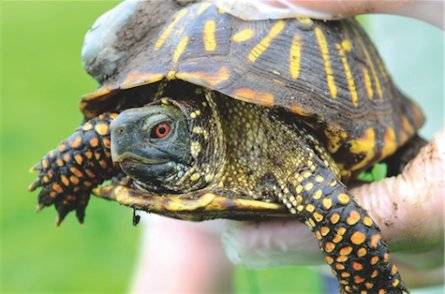Illinois
Report: Turbines likely to harm endangered species
BY DAVID GIULIANI | www.saukvalley.com 21 May 2012
BY DAVID GIULIANI | www.saukvalley.com 21 May 2012
DEER GROVE – A company’s plan for wind turbines in southeastern Whiteside County would likely harm endangered species, a state official says.
The state Department of Natural Resources is particularly concerned about the effect on the species in two nature preserves in Lee County.
Greg Wahl, who owns what he calls an undisturbed prairie near the proposed turbines in Whiteside County, has used the state report to make his case that Ireland-based Mainstream Renewable Power should place the turbines farther away.

An ornate box turtle, one of several species the Illinois Department of Natural Resources fears may be adversely affected by a wind farm planned in southeastern Whiteside County. (Alex T. Paschal/apaschal@saukvalley.com)
Across the county line are the Sand Prairie State Habitat Area and the Foley Sand Prairie Nature Preserve.
On April 4, Keith Shank of the department’s Impact Assessment Section issued recommendations to the county on how to handle the request for the wind farm, which would include turbines in Lee and Bureau counties.
In his report, Shank said the department’s biological opinion was that the turbines likely would adversely change the habitat of the ornate box turtle, plains hognose snake, and regal fritillary butterfly.
Mainstream has carefully analyzed the available habitat, but it hasn’t done on-the-ground surveys of the species, Shank said.
Mainstream’s John Martin said his company did an on-the-ground survey, but that was when species were dormant. He said Mainstream plans to do another one when they’re active.
“We’re working for the same goal,” he said. “It’s just a matter of how you tackle it. Keith has been a great guy to work with.”
The ornate box turtle burrows 3 feet underground for 6 months of the year, so excavation of power line routes and turbine foundations could run the risk of killing the species, Shank said.
“The only practical means of avoiding such outcomes is to perform such activities during the turtle’s active periods,” Shank wrote.
Shadow flicker from the turbines may mimic the movement of predators, causing stress for turtles, according to the report.
Turbine noise and vibrations are also risk factors, Shank said.
“Many reptiles are very sensitive to vibrations transmitted through the ground, …” he said.
If the county approves the project, it should require that all contractors working on the project be trained to recognize the endangered species, Shank said. Also, the county should consider posting “turtle crossing” and “snake crossing” signs on roads where the species are known to be, he said.
The department reviews proposals for wind farms and makes recommendations to protect endangered species. But counties have jurisdiction over zoning of wind farms.
Shank said the department’s role was limited.
“My job is to look for adverse impacts, not to look for benefits,” he said. “There are benefits to wind energy.”
Wind farms are relatively new, he said, so the state doesn’t have a lot of data on their long-term effects.
The Whiteside County Planning and Zoning Commission has been holding an ongoing hearing on Mainstream’s proposal. The County Board will have the final say.
Mainstream hired an expert to examine the project’s potential impacts. In January, the company sent a letter to Shank on what it had found out.
Heather Heater, a senior project manager for Rolling Meadows-based Environmental Resources Management, said in her report that the company should site turbines and transmission lines at least 100 feet from potential habitat areas for an endangered species.
Mainstream would develop an environmental monitoring plan during construction, Heater said.
“The plan would indicate that if a species is observed, all steps will be taken to avoid impacts such as routing around the area as well as reporting the observation to [the department],” she wrote.
Heater said her firm’s studies indicate that the Mainstream project area is a low-risk site for endangered species, as long as the wind company takes avoidance measures.
URL to article: https://www.wind-watch.org/news/2012/05/21/report-turbines-likely-to-harm-species/